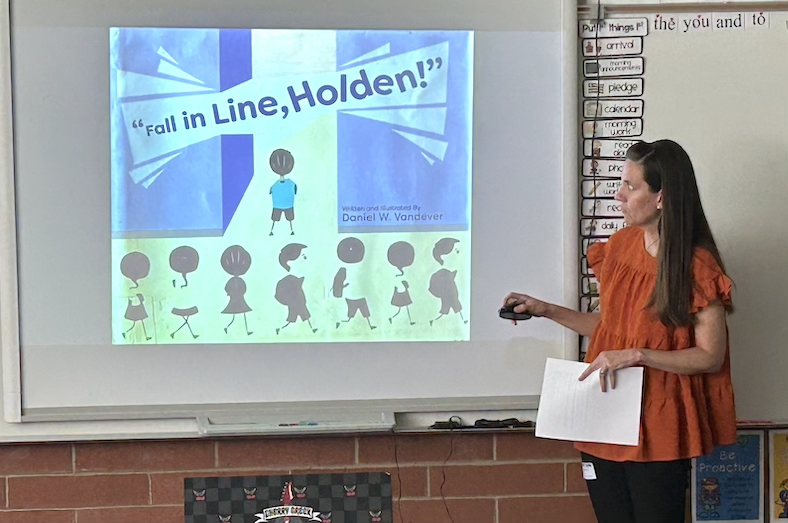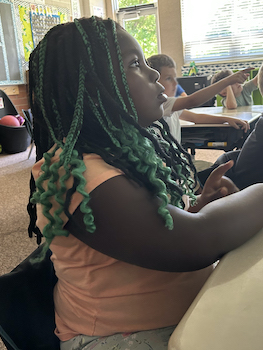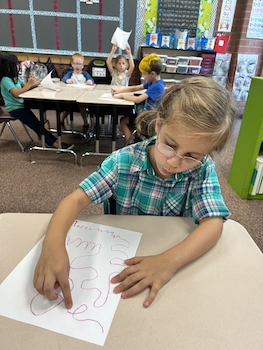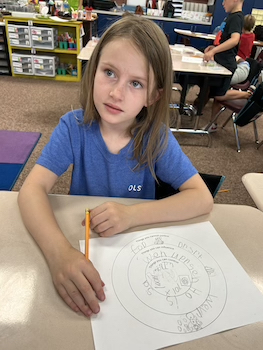SUBJECTS
GRADE
Show Results
Fall in Line, Holden: Creative Vocal Play

Lesson Summary
- Explore the book Fall in Line, Holden through vocal play.
- Determine main ideas of the book.
- Classify experiences as things you can control, things you can influence, and things you can’t control.
Lesson Plan and Procedure
Lesson Key Facts
- Grade(s): K, 1, 2, 3, 4, 5, 6
- Subject(s): English Language Arts, Health, Music, Social Studies, Native American
- Duration of lesson: 45 minutes
- Author(s): Emily Soderborg
Background information
This lesson is centered around the book Fall in Line, Holden written by Daniel Vandever, a Diné/Navajo author. Vandever states in his author’s note that the book was written with the intention of promoting creative thinking and originality. The book shares his Indigenous perspective of finding resilience from past events, and his optimism for all to move forward with both Western and traditional knowledge by taking ownership of our own future.
The BYU ARTS Partnership recognizes that there is power in the arts and personal creativity. Participation in the arts can provide healing experiences that develop resilience. The arts are a way to express feelings in a safe way without the need to find the words to express those feelings. Through this artistic process, we emphasize that every child matters. Every person deserves the opportunity to reflect on how they process their own experiences. While we cannot control the actions of others, we do have the power to control ourselves, and determine how we react and what we will become. The hope is that each participant will gain insight into what they already do and what they can do to make the best out of less-than-ideal situations.
Access slides for this lesson.
Vocalizing Lines
Teacher: Imagine our class walking down the hall to recess. What do you think the line of students should look like?
Draw a straight line on the board.
Teacher: What should the line of students sound like? What sounds could we make with our voices to represent students in a single file line? In a book we are going to read today, there is a repeated phrase, “We all fall in line.” On that phrase will sing the words on one pitch and then hold out the note on “ooh” to represent being in line.
Model for students singing the words on one pitch and then vocalizing on “ooh” to reflect being in line.
Open the book and start reading.
Teacher: On this first page of the book, it uses a big word, “conformity.” What does conformity mean? When a person conforms, it means that person is the same as those around him or her. Conformity also means behaving in a certain way--according to set expectations, or the way things are usually done.
Teacher: A music word we use to mean doing something the same as someone else is “unison.” When we sing in unison, we all sing the same note at the same time.
Practice singing one note together.
Teacher: Every time we come to the phrase “we all fall in line,” we’ll sing those words on one note in unison, and then hold out the note on “ooh.”
Teacher: There is a character in this book named Holden. Holden is a student in a boarding school. In this school Holden’s teacher has expectations for how the class should walk through the halls. Holden can’t change those expectations—they are not in his control. However, Holden is in control of his thoughts and his imagination, and how he chooses to control his imagination allows him to have increased joy, fun, and even excitement in his walk down the hall. Let’s see what happens.
Read pages 2-4. Stop at page 5.
Teacher: Look at this page. What do you notice in the illustrations? What did Holden choose to see?
Listen to student responses.
Teacher: Instead of a straight line, we’ll represent Holden’s view with a twisty twirly line. Let’s see one way this could look and sound.

Draw or show the first vocal play line. Model for students how to “read” the line with your voice. Follow the line by pointing with your finger while vocalizing on a neutral syllable (e.g. ah, oo, oh, ee) to reflect the highs, lows, swoops, and dives of this pathway.
Teacher: Now, it’s your turn to follow this line with your voice. You don’t need to do it the same way I did. There is no wrong way to do vocal play. We play with our voices to develop vocal flexibility. Flexibility means being able to do things in lots of different ways. Flexibility is an opposite of conformity.
Encourage students to try vocalizing the line more than once in different ways. Side-coaching prompts could include: Can you start in a different place in your voice? Could your voice go even higher and lower? What if I flip the pathway a different direction? How would that change the way it sounds?
To get students attention, sing the phrase, “Fall in line, Holden” all on one pitch, and hold out an “ooh” for all students to join singing in unison.
Continue reading through the book. On each page, as Holden imagines new ideas, invite students to explore another vocal play line with their voices. Bring students’ focus back to the book by singing the phrase, “Fall in line, Holden” all on one pitch and again holding the note on an “ooh” until all students have joined in.
Creating Vocal Play Lines
When you reach the last page of the book, give each student a piece of paper and a crayon/marker for them to draw their own vocal play pathway. Another option would be to give each student a pipe cleaner and have them shape it into a vocal play pathway.

Teacher: As you create your own vocal play pathway, make sure it is readable. If I scribble a mess of lines, will I be able to follow it with my voice? (Or if I scrunch the pipe cleaner into a tight ball, can I see where it is going so I can follow it with my voice?)
Teacher: We now get to vocalize Holden’s class’s walk through the hall to recess by following a complete line map. When the lines are straight, we’ll sing on one note in unison. When the lines twist and turn, we each get to play with our voices. And when it gets to the doors for recess, you will get to follow your own vocal play pathway you just created.
Vocalize the line map together as a class.
Teacher: What did you think about that experience? Can you think of situations where you might want to be the same as those around you—where you want to conform? When we sing in unison, it sounds beautiful to all be doing the same thing. Can you think of other situations where you might want to be different from those around you—where you want to have flexibility to do things your own way?
Circles of Influence
Teacher: There were some things in this story that Holden couldn’t control and there were other things that he did have control over. He had control over his own imagination, and that made his journey more colorful and happier. When you focus on things you can control, you are able to be happier and more successful.
Hand out graphic organizer.
Teacher: This is called the Circles of Control, and is an idea developed by a man named Stephen Covey. As we discuss this, you will draw or write ideas in each circle. Each circle represents a group of things or situations that we give attention to.

Teacher: This outside circle is called the circle of concern. This circle has things we often worry about but cannot control no matter what we do. In our lesson today, you did not have any control over which book we read together. I had already made that choice before coming to class today, and you had no say. This circle also includes things like the weather. You can’t control if it rains or not. Can you think of other things that might go in this circle?
Possible responses:
- The Weather
- World Problems
- Past Actions
- Family member’s health
- Parents’ work
Draw pictures or write words modelling the process of filling in the graphic organizer.
Teacher: After the circle of concern, we enter the circle where we can influence things around us in some ways, called the circle of influence. In our lesson today, I couldn’t control how you felt about reading the book, but I could do my best to make it interesting and non-threatening as we vocalized it together. For another example, you might have a friend who is feeling sad. You cannot control his or her emotions, but you can say kind words to them, that could influence their feelings. What are some things you might have influence over, but are not completely in your control?
Possible responses:
- What others say
- How others feel
- The behavior of others
- How others react to us
- Whether people like me or not
- How someone treats me
- Others being kind
Model writing or drawing additional ideas in this circle.
Teacher: We might worry about all of the things in each circle, but really, only one circle deserves the majority of our time and energy—that’s the innermost circle. This innermost circle has all the things that we can directly control, regardless of what is happening in the outer two circles. Today, you had complete control over what the last vocal play pathway would be. You got to design the shape and decide what it sounded like for you. Another example includes your mood. Even though you can’t control if it rains, you can definitely decide how the rain affects your mood. Other things that fall in the circle of control include your attitude, what you read and watch, how you respond to others, and how you spend your time. What are other things that you can control?
Possible responses:
- My words
- How I treat others
- My thoughts/imagination
- My behavior
- My attitude/mindset
- My reactions
- Asking for help
- Being kind
- The friends I choose to have
- Working hard/the amount of energy you put into something
- My goals

Teacher: When you focus on the things that you can actually do something about, it increases your resilience, productivity, and success, and helps you better manage your own stress. Focusing on your circle of control allows you to become more flexible in life. You are more open to different outcomes. In other words, you continue doing your best while being more accepting of the things that cannot be changed.
Teacher: In the book, how did Holden’s focus on his circle of control make a difference for him and for the other students?
Teacher: The book, Fall in Line, Holden, is about a boy who lived in a Native American boarding school. The author of the book, Daniel Vandever, is Native American, specifically Navajo/Diné. He shares in the author’s note and acknowledgement at the end of the book that many Indigenous people were and still are impacted by the time when Native Americans were sent to boarding schools. He says we can take ownership of our own futures based on the resilience of our past. Taking ownership of your future means focusing on those things that are in your own circle of control.
Have a simple, open discussion about questions students may have.
Teacher: What are some of the things you will remember most from this lesson?
Learning Objectives
- Increase vocal flexibility, which will lead to in-tune singing, through vocal play.
- Tell a story through sounds instead of words.
- Categorize things or situations into circles of control.
- Take responsibility for your own actions.
Utah State Board of Education Standards
This lesson can be used to meet standards in many grades and subject areas. We will highlight a few grade’s standards to give an example of application.
Grade 1 Music
- Standard 1.M.CR.3: Organize personal musical ideas using iconic notation or recordings.
- Standard 1.M.P.3.a: Develop techniques and concepts to refine work for presentation by exploring the range and various qualities of the voice.
- Standard 1.M.CO.1: Describe how music relates to personal experience, use life experience and additional content knowledge to inspire and respond to music, and deepen understanding of another content area through music.
Grade 1 Health Education
- Standard 1.HF.2: Explain how to make good decisions and how all decisions can affect self or others.
Grade 1 English Language Arts
- Standard 1.R.5: Ask and answer questions about key details in a text. (RL & RI)
- Standard 1.R.6: Read a variety of texts including those from diverse cultures to identify and retell the main idea and key details of a text. (RL & RI)
- Standard 1.R.7: Describe characters, settings, and important events in a story (RL) or pieces of information in a text. (RI)
Grade 1 Social Studies
- Standard 1.2.1: Construct a simple map of a neighborhood, classroom, school, or the setting of a story.
- Standard 1.3.5: Demonstrate characteristics of responsible citizenship (for example, respect others’ property, treat people with dignity, find solutions to conflicts, take responsibility for one’s actions, take care of school grounds).
Grade 3 Music
- Standard 3.M.CR.2: Select and demonstrate musical ideas to express intent while connecting to purpose and context, and organize personal musical ideas using iconic notation or recordings to combine and/or sequence personal rhythmic and melodic ideas.
- Standard 3.M.P.5: Respond to visual representations of melodic contour and simple melody patterns.
- Standard 3.M.R.4: Describe feelings or imagery conveyed by a music selection.
- Standard 3.M.CO.1: Describe how music relates to personal, social, emotional, and intellectual development; use life experience and additional content knowledge to inspire and respond to music and deepen understanding of another content area through music.
Grade 3 Health Education
- Standard 3.MEH.1: Identify healthy strategies individuals may use to cope with disappointment, grief, sadness, and loss, including talking with a trusted adult.
- Standard 3.MEH.2: Define positive and negative stress and identify how each type feels. Identify behaviors or ways to alleviate stress.
Grade 3 English Language Arts
- Standard 3.R.5: Ask and answer questions to demonstrate understanding of a text, referring explicitly to the text as the basis for the answers. (RL & RI)
- Standard 3.R.6: Read a variety of texts including those from diverse cultures, retell the text according to the text structure including the main idea and how key details support the main idea. (RL & RI)
- Standard 3.R.7: Describe characters in a story and explain how their actions contribute to the sequence of events. (RL) Describe the relationship between a series of historical events, scientific ideas or concepts, or steps in technical procedures in a text, using language that pertains to time, sequence, and cause/effect. (RI)
- Standard 3.R.12: Explain how specific illustrations or text features contribute to what is conveyed by the words in a text. (RL & RI)
Grade 3 Social Studies
- Standard 3.3.1: Analyze how their community has been shaped by the diverse people who have resided within it. Compare primary and secondary sources (when available) from or about these people.
- Standard 3.3.7: Discuss how the choices of individuals and leaders affect their community and its future (for example, supporting local businesses, volunteering, voting).
Grade 5 Music
- Standard 5.M.CR.2: Explain the connection to specific purpose and context.
- Standard 5.M.CR.5: Organize personal musical ideas using iconic notation or recordings to combine and/or sequence personal rhythmic, melodic and harmonic ideas.
- Standard 5.M.R.4: Describe feelings or imagery conveyed by a music selection.
- Standard 5.M.CO.1: Describe how music relates to personal, social, emotional, and intellectual development.
- Standard 5.M.CO.3: Deepen understanding of another content area through music.
Grade 5 Health Education
- Standard 5.MEH.1: Practice a variety of stress management techniques.
Grade 5 English Language Arts
- Standard 5.R.6: Determine the theme or main idea of a text including those from diverse cultures and how it is conveyed through particular details and summarize the text. (RL & RI)
- Standard 5.R.8: Determine the meaning of words, phrases, figurative language, academic and content-specific words, and analyze their effect on meaning within a text. (RL & RI)
- Standard 5.R.12: Analyze how the visual and multimedia elements contribute to the meaning, tone, or beauty of a text. (RL) Draw on information from multiple sources including media to locate an answer to a question or to solve a problem. (RI)
Grade 5 Social Studies
- Standard 5.4.3: Summarize the impacts of forced relocation and assimilation on Native American people and how they have preserved their communities in the face of such adversity.
Equipment and Materials Needed
- Vandever, Daniel W. Fall in line, Holden. Flagstaff, AZ: Salina Bookshelf, Inc., 2017.
- Slide presentation for lesson plan
- Vocal play lines (single line on each page)
- Vocal play lines (four per page)
- Vocal play map of Holden’s walk to recess
- Circles of Influence description image
- Circles of Influence graphic organizer
- Blank paper
- Crayons or markers
Additional Resources
This lesson was created thanks to a grant from the National Endowment for the Arts and the Utah Division of Arts & Museums.
The following lessons also focus on books by indigenous authors that highlight “Every Child Matters”:
Image References
Image 1: Brenda Beyal
Image 2: Curtis Soderborg
Images 3-4: Brenda Beyal
Image 5: Curtis Soderborg

www.education.byu.edu/arts/lessons
 Download
Download